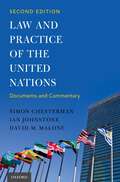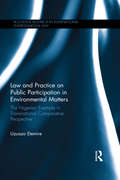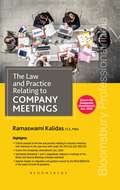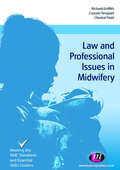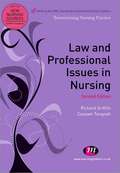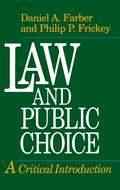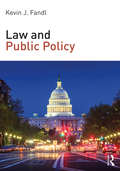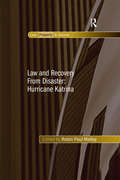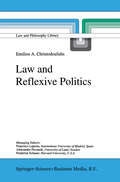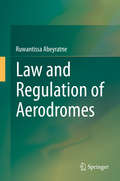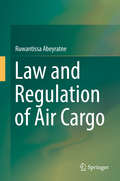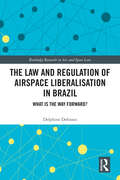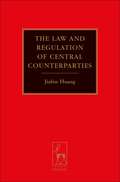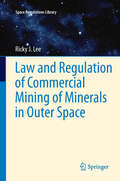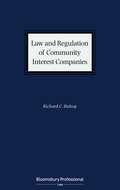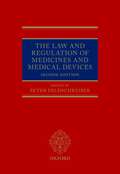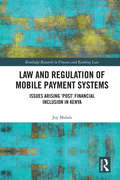- Table View
- List View
Law and Practice of the United Nations
by Simon Chesterman Ian Johnstone David M. MaloneLaw and Practice of the United Nations: Documents and Commentary combines primary materials with expert commentary demonstrating the interaction between law and practice in the UN organization, as well as the possibilities and limitations of multilateral institutions in general. Each chapter begins with a short introductory essay describing how the documents that ensue illustrate a set of legal, institutional, and political issues relevant to the practice of diplomacy and the development of public international law through the United Nations. Each chapter also includes questions to guide discussion of the primary materials, and a brief bibliography to facilitate further research on the subject. This second edition addresses the most challenging issues confronting the United Nations and the global community today, from terrorism to climate change, from poverty to nuclear proliferation. New features include hypothetical fact scenarios to test the understanding of concepts in each chapter. This edition contains expanded author commentary, while maintaining the focus on primary materials. Such materials enable a realistic presentation of the work of international diplomacy: the negotiation, interpretation and application of such texts are an important part of what actually takes place at the United Nations and other international organizations. This work is ideal for courses on the United Nations or International Organizations, taught in both law and international relations programs.
Law and Practice of the United Nations
by David M. Malone Ian Johnstone Simon ChestermanLaw and Practice of the United Nations: Documents and Commentary combines primary materials with expert commentary demonstrating the interaction between law and practice in the UN organization, as well as the possibilities and limitations of multilateral institutions in general. Each chapter begins with a short introductory essay describing how the documents that ensue illustrate a set of legal, institutional, and political issues relevant to the practice of diplomacy and the development of public international law through the United Nations. Each chapter also includes questions to guide discussion of the primary materials, and a brief bibliography to facilitate further research on the subject. This second edition addresses the most challenging issues confronting the United Nations and the global community today, from terrorism to climate change, from poverty to nuclear proliferation. New features include hypothetical fact scenarios to test the understanding of concepts in each chapter. This edition contains expanded author commentary, while maintaining the focus on primary materials. Such materials enable a realistic presentation of the work of international diplomacy: the negotiation, interpretation and application of such texts are an important part of what actually takes place at the United Nations and other international organizations. This work is ideal for courses on the United Nations or International Organizations, taught in both law and international relations programs.
Law and Practice on Public Participation in Environmental Matters: The Nigerian Example in Transnational Comparative Perspective (Routledge Research in International Environmental Law)
by Uzuazo EtemirePublic participation has become a recurring theme and a topical issue in the field of international environmental law, with many multilateral environmental instruments calling on states to guarantee effectively the concept in their laws and practices. This book focuses on public participation in environmental governance, in terms of public access to environmental information and public participation in environmental decision-making processes. Drawing on the body of international best practice principles in environmental law and taking a comparative stance, Uzuazo Etemire takes Nigeria as a key case, evaluating its procedural laws and practices in relation to public access to information and participation in decision-making in environmental matters. In working to clarify and deepen understanding of the current status of environmental public participation rights in Nigeria, the book addresses key issues in environmental governance for developing and transitional countries and the potential for public participation to improve the state of the environment and public wellbeing. This book will be of great interest to undergraduate students (as further reading) and post-graduate students, academics, researchers, relevant government agencies and departments, policy-makers and NGOs in the fields of international environmental law, environmental justice, environmental/natural resource management, development studies and international finance.
Law and Practice on Public Participation in Environmental Matters: The Nigerian Example in Transnational Comparative Perspective (Routledge Research in International Environmental Law)
by Uzuazo EtemirePublic participation has become a recurring theme and a topical issue in the field of international environmental law, with many multilateral environmental instruments calling on states to guarantee effectively the concept in their laws and practices. This book focuses on public participation in environmental governance, in terms of public access to environmental information and public participation in environmental decision-making processes. Drawing on the body of international best practice principles in environmental law and taking a comparative stance, Uzuazo Etemire takes Nigeria as a key case, evaluating its procedural laws and practices in relation to public access to information and participation in decision-making in environmental matters. In working to clarify and deepen understanding of the current status of environmental public participation rights in Nigeria, the book addresses key issues in environmental governance for developing and transitional countries and the potential for public participation to improve the state of the environment and public wellbeing. This book will be of great interest to undergraduate students (as further reading) and post-graduate students, academics, researchers, relevant government agencies and departments, policy-makers and NGOs in the fields of international environmental law, environmental justice, environmental/natural resource management, development studies and international finance.
Law and Practice relating to Company Meetings
by Ramaswami KalidasAbout the bookThe book contains an incisive analysis of the law and practice relating to the holding of meetings of the board, various committees constituted by the Board and general meetings of the members including meetings held specifically under the statute for different stakeholders. The book explains lucidly the paradigm shift which has been brought about in the Companies Act, 2013 as compared to the 1956 Act in the matter of conducting meetings, use of audio visual means for attending meetings etc.The book will be of immense value to the professional fraternity as well as those aspiring to enter the profession, company directors, academicians as also the dilettante. The book should enable the professionals to organize meetings in a systematic manner as practical insights have been provided on these aspects, given the author's four-decade long interface with the Industry. The annexures to the book contain the relevant provisions in the Act, Rules, Regulations, Secretarial Standards etc to facilitate co-relation with the discussion in the chapters of the book.Key featuresThis book is an exhaustive treatise on the Banning of Unregulated Deposit Schemes Act, 2019 including - Critical analysis of the law and practice relating to company meetings with reference to the case laws both under the present Act and its predecessor, the 1956 Act. Specific reference to SEBI (Listing Obligations and Disclosure Requirements) Regulations governing conduct of meetings by listed companies. Contains amendments made by the Companies (Amendment) Act, 2019. Relevant amendments proposed by the Companies (Amendment) Bill, 2020 have been analysed. Secretarial Standards 1 (Meetings of the Board of Directors) and 2 (General Meetings) have been critically examined. Ambiguities in the law explained and dealt-with pragmatically under various topics. Ready reference to the law, relevant Rules, SEBI Regulations, Notifications and Circulars to make the edition contemporaneous.
Law and Professional Issues in Midwifery (1st edition) (PDF)
by Cassam Tengna Chantal Patel Richard GriffithMidwives are accountable to the public, patients, their employers and the profession. It is essential that student midwives have a clear understanding of the legal and professional dilemmas they face in the course of their career and how to address those dilemmas in order to practise effectively. This book is an essential resource for student midwives developing their knowledge and understanding of the requirements for safe practice. It provides a clear introduction to the subject, with activities and case studies throughout to illustrate key principles and apply the law in context.
Law and Professional Issues in Nursing (2nd edition)
by Richard Griffith Cassam TengnahNurses are more accountable than ever to the public, patients, their employers and the profession and it is vital that they have a clear understanding of the legal, ethical and professional dilemmas they will face in the course of their professional career. This book is an essential resource for student nurses as they begin to develop their knowledge and understanding of the requirements for safe practice in healthcare. This new edition includes increased coverage of protection of vulnerable adults and ethics and principled decision making.
Law and Public Choice: A Critical Introduction (Economic Approaches To Law Ser.)
by Daniel A. Farber Philip P. FrickeyIn Law and Public Choice, Daniel Farber and Philip Frickey present a remarkably rich and accessible introduction to the driving principles of public choice. In this, the first systematic look at the implications of social choice for legal doctrine, Farber and Frickey carefully review both the empirical and theoretical literature about interest group influence and provide a nonmathematical introduction to formal models of legislative action. Ideal for course use, this volume offers a balanced and perceptive analysis and critique of an approach which, within limits, can illuminate the dynamics of government decision-making. “Law and Public Choice is a most valuable contribution to the burgeoning literature. It should be of great interest to lawyers, political scientists, and all others interested in issues at the intersection of government and law.”—Cass R. Sunstein, University of Chicago Law School
Law and Public Choice: A Critical Introduction
by Daniel A. Farber Philip P. FrickeyIn Law and Public Choice, Daniel Farber and Philip Frickey present a remarkably rich and accessible introduction to the driving principles of public choice. In this, the first systematic look at the implications of social choice for legal doctrine, Farber and Frickey carefully review both the empirical and theoretical literature about interest group influence and provide a nonmathematical introduction to formal models of legislative action. Ideal for course use, this volume offers a balanced and perceptive analysis and critique of an approach which, within limits, can illuminate the dynamics of government decision-making. “Law and Public Choice is a most valuable contribution to the burgeoning literature. It should be of great interest to lawyers, political scientists, and all others interested in issues at the intersection of government and law.”—Cass R. Sunstein, University of Chicago Law School
Law and Public Choice: A Critical Introduction
by Daniel A. Farber Philip P. FrickeyIn Law and Public Choice, Daniel Farber and Philip Frickey present a remarkably rich and accessible introduction to the driving principles of public choice. In this, the first systematic look at the implications of social choice for legal doctrine, Farber and Frickey carefully review both the empirical and theoretical literature about interest group influence and provide a nonmathematical introduction to formal models of legislative action. Ideal for course use, this volume offers a balanced and perceptive analysis and critique of an approach which, within limits, can illuminate the dynamics of government decision-making. “Law and Public Choice is a most valuable contribution to the burgeoning literature. It should be of great interest to lawyers, political scientists, and all others interested in issues at the intersection of government and law.”—Cass R. Sunstein, University of Chicago Law School
Law and Public Policy
by Kevin J. FandlLaws exist to incentivize us to act in a certain manner, in accordance with the policies that our community has deemed right for us. And when we disagree with those laws, we must re-examine our policies, and thus our beliefs and ideas, to decide whether our community has changed. This is a book about law and public policy—about the ideas and the rules we build to implement those rules. While similar books have looked at public policy and public administration in an effort to explain how the government works, and others have considered the foundations of the legal system to understand the rulemaking institutions, this book takes a different approach. In this ground-breaking new textbook, author Kevin Fandl develops a complete picture of society, from idea to action -- by examining laws through the lens of policy, and vice versa. This holistic approach gives readers a chance to see not only why certain rules exist, but how those rules evolved over time and the events that inspired them. It offers readers an opportunity not only to see but also to participate in the process of forming the structures that shape our society. This textbook is divided into two sections. The first section provides readers with the tools that they will need to digest the policies and laws that surround them. These tools include a historical deep dive into the foundations of the governance structure in the United States and beyond, an important examination of civics and a reminder of the importance of engaging in the policymaking process, a careful breakdown of the institutions that form the backbone of the law and policy-making institutions in the United States, and finally critical thinking including practical tools to find reliable sources for news, research, and other types of information. The second section of the text is comprised of subject-matter analyses. These subject-based chapters, written by experts on the topic at hand begin with a historical perspective, followed by a careful examination of the key policies and laws that inform that field. Each chapter highlights key vocabulary, provides practical vignettes to add context to the writing, explores a unique global component to compare perspectives from communities worldwide, and includes a number of discussion questions and recommended readings for further examination. This textbook is tailored specifically for undergraduate and graduate students of public policy, to introduce them to the role of law and legal institutions as facilitators and constraints on public policy, exploring those laws in a range of relevant policy contexts with the help of short case studies.
Law and Public Policy
by Kevin J. FandlLaws exist to incentivize us to act in a certain manner, in accordance with the policies that our community has deemed right for us. And when we disagree with those laws, we must re-examine our policies, and thus our beliefs and ideas, to decide whether our community has changed. This is a book about law and public policy—about the ideas and the rules we build to implement those rules. While similar books have looked at public policy and public administration in an effort to explain how the government works, and others have considered the foundations of the legal system to understand the rulemaking institutions, this book takes a different approach. In this ground-breaking new textbook, author Kevin Fandl develops a complete picture of society, from idea to action -- by examining laws through the lens of policy, and vice versa. This holistic approach gives readers a chance to see not only why certain rules exist, but how those rules evolved over time and the events that inspired them. It offers readers an opportunity not only to see but also to participate in the process of forming the structures that shape our society. This textbook is divided into two sections. The first section provides readers with the tools that they will need to digest the policies and laws that surround them. These tools include a historical deep dive into the foundations of the governance structure in the United States and beyond, an important examination of civics and a reminder of the importance of engaging in the policymaking process, a careful breakdown of the institutions that form the backbone of the law and policy-making institutions in the United States, and finally critical thinking including practical tools to find reliable sources for news, research, and other types of information. The second section of the text is comprised of subject-matter analyses. These subject-based chapters, written by experts on the topic at hand begin with a historical perspective, followed by a careful examination of the key policies and laws that inform that field. Each chapter highlights key vocabulary, provides practical vignettes to add context to the writing, explores a unique global component to compare perspectives from communities worldwide, and includes a number of discussion questions and recommended readings for further examination. This textbook is tailored specifically for undergraduate and graduate students of public policy, to introduce them to the role of law and legal institutions as facilitators and constraints on public policy, exploring those laws in a range of relevant policy contexts with the help of short case studies.
Law and Recovery From Disaster: Hurricane Katrina (Law, Property and Society)
by Robin Paul MalloyIn August of 2005, Hurricane Katrina hit the Gulf Coast of the United States, directly affecting 1.5 million people. Only one year earlier, an Indian Ocean tsunami struck Indonesia, destroying or damaging more than 370,000 homes. As forces of nature, hurricanes, tsunamis, earthquakes and floods are not limited to occurrences in any one community or any one country. In Law and Recovery from Disaster: Hurricane Katrina, attention is focused on the ability of law and legal institutions to not only survive such disasters but to effectively facilitate recovery. Using Hurricane Katrina as a lens, contributors address a wide range of issues of interest to people concerned about property law, disaster preparedness, housing, insurance, small business recovery, land use planning and the needs of people with disabilities. While Hurricane Katrina is the focal point for discussion, the lessons learned are readily applicable to a variety of disaster situations in a wide range of global settings.
Law and Recovery From Disaster: Hurricane Katrina (Law, Property and Society)
by Robin Paul MalloyIn August of 2005, Hurricane Katrina hit the Gulf Coast of the United States, directly affecting 1.5 million people. Only one year earlier, an Indian Ocean tsunami struck Indonesia, destroying or damaging more than 370,000 homes. As forces of nature, hurricanes, tsunamis, earthquakes and floods are not limited to occurrences in any one community or any one country. In Law and Recovery from Disaster: Hurricane Katrina, attention is focused on the ability of law and legal institutions to not only survive such disasters but to effectively facilitate recovery. Using Hurricane Katrina as a lens, contributors address a wide range of issues of interest to people concerned about property law, disaster preparedness, housing, insurance, small business recovery, land use planning and the needs of people with disabilities. While Hurricane Katrina is the focal point for discussion, the lessons learned are readily applicable to a variety of disaster situations in a wide range of global settings.
Law and Reflexive Politics (Law and Philosophy Library #35)
by E.A. ChristodoulidisLaw is the great concealer; and law is everywhere. Or so claimed Marxists once upon a time. [Law] was imbricated within the mode of production and productive relations themselves . . . it intruded brusquely within alien categories, re-appearing bewigged and gowned in the form of ideology; . . . it was an arm of politics and politics was one of its arms; it was an academic discipline, subjected to the rigour of its own autonomous logic, it contributed to the definition of the self-identity of both the rulers 1 and the ruled. Does the old critique of domination still hold any sway? Apparently not. Or so even scholars of the far Left keep reminding us in their eagerness to embrace law and proclaim their allegiance to the new constitutional politics of civil society. Old Marxists now describe popular sovereignty as 'co-original' with, and democracy 'internally linked' to 2 constitutional rights and find it hard to remember what it was they once disagreed with liberals about. No tension left between emancipatory politics and oppressive law; instead we have reciprocal constitution, simultaneous realisation. In the Left's embracing of the new constitutionalisms its old critique of law - the critique of the law's concealment of class inequality, class conflict and class action - is left behind.
Law and Regulation of Aerodromes
by Dr. Ruwantissa AbeyratneThis book encapsulates in detail the principles pertaining to legal and regulatory aspects of aerodromes. As the title denotes, it discusses the various aspects of the structure and functioning of an aerodrome and the complexities involved. It focuses on the law and regulation of aerodrome certification and planning, aerodrome services, financial and economic planning, security, management and governance.The airport industry is one of the fastest growing within the aviation industry, requiring innovation and creativity in management. This in turn has called for an increased focus on advanced management programmes for airport managers and lawyers. The Airport Management Professional Accreditation Programme (AMPAP) offered worldwide by the International Civil Aviation Organization and Airports Council International, and the Angkasa Pura II Airport Management Excellence Programme of Indonesia are two such initiatives which give airport professionals a sound grounding on the principles and techniques of management and law.
Law and Regulation of Air Cargo
by Ruwantissa AbeyratneThis book explores the legal and regulatory aspects of the complex air cargo sector, discussing in detail the general principles of the carriage of air cargo; artificial intelligence and air cargo; facilitation; carriage of hazardous goods; human remains; and animals, as well as cargo security; price fixing and anti competitive conduct in air cargo operations; liability issues; the air cargo supply chain and contract of carriage. It also discusses related achievements of the International Civil Aviation Organization; the International Air Transport Association and Airports Council International. The value of goods carried by airlines represents 7.4% of the global Gross Domestic Product. While cargo carried by air accounts for less than 1% of global cargo carriage, airlines carry 35% of the value of world trade, making this industry highly valuable and efficient, and the most reliable way to transport goods throughout the world. On average, airlines transport 52 million metric tons of goods per annum, worth an equivalent of $6.8 trillion, i.e. $18.6 billion worth of goods daily.
The Law and Regulation of Airspace Liberalisation in Brazil: What is the Way Forward? (Routledge Research in Air and Space Law)
by Delphine DefossezThe book starts from the premise that the current aviation framework, in Brazil, cannot sustain a full liberalisation in the long run. While the competition rules in place offer a strong framework, which only requires small modifications, these rules are not "enough" to foster a "healthy" liberalisation. In fact, until recently, Brazilian airlines were operating in a homogenous market, where competition was artificial. This artificial competition, obtained through the imposition of a legal obligation to provide water and a snack and grant a 23kg bag allowance, has resulted in a highly concentrated domestic market with very few players. Compared to other same size markets, such as China or India, Brazil is far behind in terms of airlines operating at national level. Consequently, the opening of the domestic market must be closely regulated to avoid national carriers suffocating under external pressure. For this reason, state intervention during the liberalisation process is crucial. State intervention is also with regard to the protection of passengers. The other major problem is the protection framework for passengers which is much too uncertain and burdensome. In a sense, it is detrimental to the domestic market and passengers. Indeed, there is no harmonisation of passenger compensation leading to contradictory judgments and possible high moral damages which hinders legal certainty for airlines. Compared to the situation in the EU, in Brazil, airlines have a limited range of defences, which are often dismissed by courts. This book, therefore, critically analyses the policies and regulations in place by mainly comparing the Brazilian framework to the European one. This choice has been motivated by the fact that European liberalisation is considered the best so far, and as Brazil is starting this process much later, it could benefit from the European experience. This book will be of particular interest to scholars and practitioners interested in the Brazilian system.
The Law and Regulation of Airspace Liberalisation in Brazil: What is the Way Forward? (Routledge Research in Air and Space Law)
by Delphine DefossezThe book starts from the premise that the current aviation framework, in Brazil, cannot sustain a full liberalisation in the long run. While the competition rules in place offer a strong framework, which only requires small modifications, these rules are not "enough" to foster a "healthy" liberalisation. In fact, until recently, Brazilian airlines were operating in a homogenous market, where competition was artificial. This artificial competition, obtained through the imposition of a legal obligation to provide water and a snack and grant a 23kg bag allowance, has resulted in a highly concentrated domestic market with very few players. Compared to other same size markets, such as China or India, Brazil is far behind in terms of airlines operating at national level. Consequently, the opening of the domestic market must be closely regulated to avoid national carriers suffocating under external pressure. For this reason, state intervention during the liberalisation process is crucial. State intervention is also with regard to the protection of passengers. The other major problem is the protection framework for passengers which is much too uncertain and burdensome. In a sense, it is detrimental to the domestic market and passengers. Indeed, there is no harmonisation of passenger compensation leading to contradictory judgments and possible high moral damages which hinders legal certainty for airlines. Compared to the situation in the EU, in Brazil, airlines have a limited range of defences, which are often dismissed by courts. This book, therefore, critically analyses the policies and regulations in place by mainly comparing the Brazilian framework to the European one. This choice has been motivated by the fact that European liberalisation is considered the best so far, and as Brazil is starting this process much later, it could benefit from the European experience. This book will be of particular interest to scholars and practitioners interested in the Brazilian system.
The Law and Regulation of Central Counterparties
by Jiabin HuangThe Law and Regulation of Central Counterparties provides a detailed analysis of the legal and regulatory aspects of Central Counterparties (CCPs) with an introduction to their role and functions in modern financial markets. The book begins by describing in detail basic elements of modern post-trade infrastructure, exploring the modern functional and operational aspects of CCPs in the markets. It moves on to discuss the relationships between CCPs and their members, and clients of clearing members as non-members, legal issues concerning collateralisation, netting and set-off, and default arrangements that are primarily embedded in the form of the rules and regulations of CCPs. With regard to regulatory issues, the book examines the regulatory framework with reference to the UK and the EU. As to the case for a single CCP for various different types of markets, the analysis covers the advantages and disadvantages of CCP clearing and carries out an assessment of the risks and benefits of a single multi-market CCP.
Law and Regulation of Commercial Mining of Minerals in Outer Space (Space Regulations Library #7)
by Ricky LeeThis monograph addresses the legal and policy issues relating to the commercial exploitation of natural resources in outer space. It begins by establishing the economic necessity and technical feasibility of space mining today, an estimate of the financial commitments required, followed by a risk analysis of a commercial mining venture in space, identifying the economic and legal risks. This leads to the recognition that the legal risks must be minimised to enable such projects to be financed. This is followed by a discussion of the principles of international space law, particularly dealing with state responsibility and international liability, as well as some of the issues arising from space mining activities. Much detail is devoted to the analysis of the content of the common heritage of mankind doctrine. The monograph then attempts to balance such interests in creating a legal and policy compromise to create a new regulatory regime.
Law and Regulation of Community Interest Companies
by Richard C. BishopThis new title provides a full analysis of the legislative and regulatory backgroundof community interest companies and is a guide to all six CIC precedents:1. CIC model constitution: company limited by guarantee with a small membership2. CIC model constitution: company limited by guarantee with a large membership3. CIC model constitution: private schedule 2 company limited by shares with asmall membership4. CIC model constitution: private schedule 2 company limited by shares with alarge membership5. CIC model constitution: private schedule 3 company limited by shares with asmall membership6. CIC model constitution: private schedule 3 company limited by shares with alarge membershipThe precedents are fully annotated to provide guidance on each article, togetherwith bespoke clauses that may be included for specific events.It also uses caseexamples to demonstrate: how to create or convert to a CIC the reporting requirements with Companies House and the CIC regulatorArmed with this text any solicitor, barrister or accountant will have the tools toconfidently advise clients on the legislative and regulatory background of CICs. Thistext would also suit community bodies or individuals who wish to set up a socialenterprise using the CIC structure, in particular, sports clubs or voluntary groups.
The Law and Regulation of Medicines and Medical Devices
by Peter FeldschreiberFeldschreiber's comprehensive text on the science, regulatory policy and law surrounding new medicines and medical devices is a specialist reference for legal, medical, and pharmaceutical professionals: written by both legal and medical experts, it informs the scientifically lay lawyer of the biological science behind recent product innovations, whilst helping the legally lay researcher and developer of these products to understand the legal and regulatory framework encompassing them. Reflecting significant legal and scientific advancements since its first publication in 2008, this second edition, now entitled The Law and Regulation of Medicines and Medical Devices, has been substantially revised and reframed: key areas of review include medical device regulatory legislation (including the new Medical Devices Regulation), international regulatory procedures for life science products, the UK review on blood products, new cancer therapies, the impact of Brexit and the Covid-19 pandemic, and a greatly expanded discussion of criminal legislation on the cultivation of controlled drugs, such as cannabis, and their inclusion in the medical therapeutic armamentarium. The work introduces the structure and function of regulatory authorities and the linkage between the ethical issues underpinning clinical trials regulation, explains the intellectual property, product liability, and litigation issues surrounding life science products, and offers practical guidance on topics such as: drafting regulatory submissions; preparing litigation against decisions of the regulatory authorities; determining appropriate regulatory submission strategies throughout the European Community; and preparing litigation relating to medicinal products liability under the Product Liability Directive and the Consumer Protection Act 1987.
The Law and Regulation of Medicines and Medical Devices
by Peter FeldschreiberFeldschreiber's comprehensive text on the science, regulatory policy and law surrounding new medicines and medical devices is a specialist reference for legal, medical, and pharmaceutical professionals: written by both legal and medical experts, it informs the scientifically lay lawyer of the biological science behind recent product innovations, whilst helping the legally lay researcher and developer of these products to understand the legal and regulatory framework encompassing them. Reflecting significant legal and scientific advancements since its first publication in 2008, this second edition, now entitled The Law and Regulation of Medicines and Medical Devices, has been substantially revised and reframed: key areas of review include medical device regulatory legislation (including the new Medical Devices Regulation), international regulatory procedures for life science products, the UK review on blood products, new cancer therapies, the impact of Brexit and the Covid-19 pandemic, and a greatly expanded discussion of criminal legislation on the cultivation of controlled drugs, such as cannabis, and their inclusion in the medical therapeutic armamentarium. The work introduces the structure and function of regulatory authorities and the linkage between the ethical issues underpinning clinical trials regulation, explains the intellectual property, product liability, and litigation issues surrounding life science products, and offers practical guidance on topics such as: drafting regulatory submissions; preparing litigation against decisions of the regulatory authorities; determining appropriate regulatory submission strategies throughout the European Community; and preparing litigation relating to medicinal products liability under the Product Liability Directive and the Consumer Protection Act 1987.
Law and Regulation of Mobile Payment Systems: Issues arising ‘post’ financial inclusion in Kenya (Routledge Research in Finance and Banking Law)
by Joy MalalaOver the last ten years mobile payment systems have revolutionised banking in some countries in Africa. In Kenya the introduction of M-Pesa, a new financial services model, has transformed the banking and financial services industry. Giving the unbanked majority access to the financial services market it has attracted over 18 million subscribers which is remarkable given that fewer than 4 million people in Kenya have bank accounts. This book addresses the legal and regulatory issues arising out of the introduction of M-Pesa in Kenya and its drive towards financial inclusion. It considers the interaction between regulation and technological innovation with a particular focus on the regulatory tools, institutional arrangements and government decisional processes through the examination as a whole of its regulatory capacity. This is done with a view to understanding the regulatory capacity of Kenya in addressing the vulnerabilities presented by technological innovation in the financial industry for consumers after financial inclusion. It also examines the way that mobile payments have been regulated by criticising the piecemeal approach that the Central Bank of Kenya has taken in addressing the legal and regulatory issues presented by mobile payments. The book argues there are significant gaps in the regulatory regime of mobile banking in Kenya.
